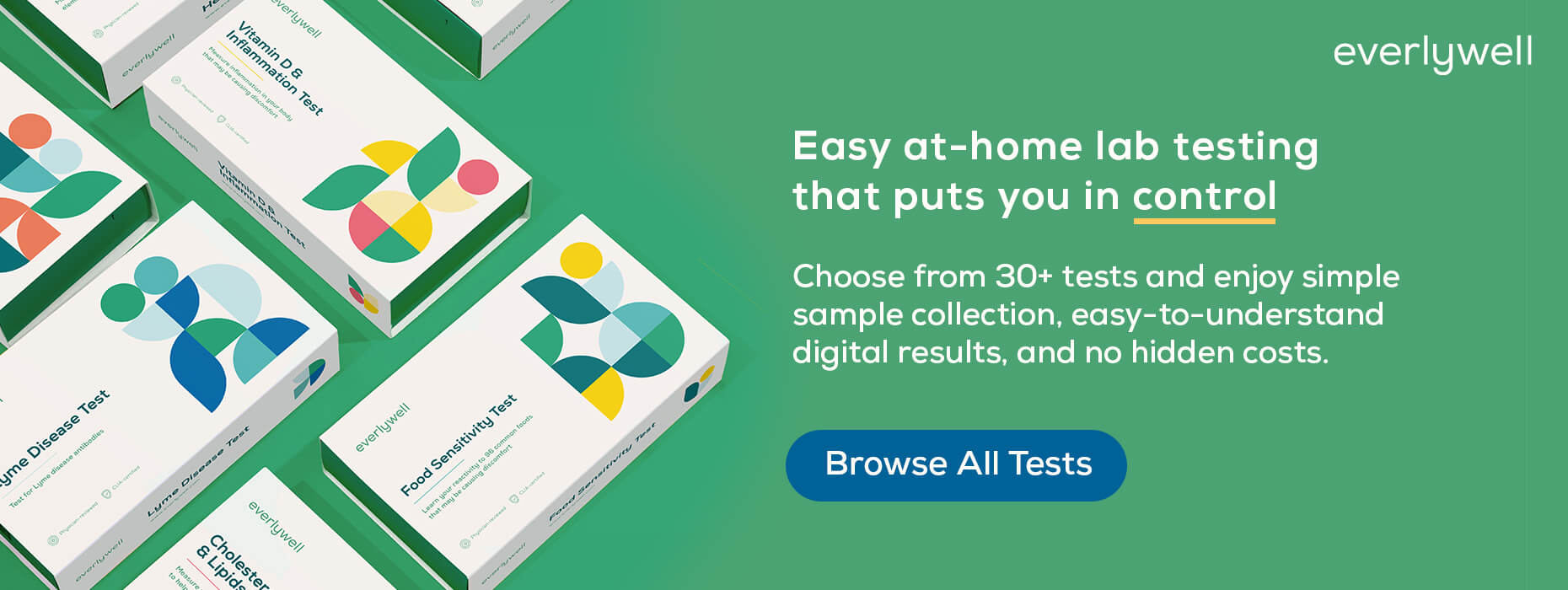
Benefits of physical activity
Medically reviewed on March 8, 2022 by Jordan Stachel, M.S., RDN, CPT. To give you technically accurate, evidence-based information, content published on the Everlywell blog is reviewed by credentialed professionals with expertise in medical and bioscience fields.
Regular physical activity is an essential part of a healthy lifestyle, but what does that really mean? Whether you decide to jog down the block, spend time in the weight room, or climb the stairs instead of taking the elevator, everyone can enjoy the benefits of physical activity.
What are those benefits?
A stronger body, a higher quality of life, and reduced health risks, for starters. This article will explore the diverse benefits of physical activity and show you simple and effective ways to start enjoying them. We’re all looking to feel our best, so read on to start creating a fitter, happier future. (To check in on hormones related to physical well-being, try the at-home Men's Health Test or Women's Health Test).
#1 Improved quality of life
Exercise doesn’t just yield results down the line—you can start reaping the rewards right away. For many, instant gratification is a major incentive and an effective motivator to start working out and stay consistent.
If you’re looking for immediate payoffs from your physical activity, you can look forward to the following quality-of-life benefits of exercise:
Better sleep – Looking for a way to wake up bright-eyed and bushy-tailed? If you struggle to fall asleep or stay asleep, regular physical activity may provide an all-natural remedy. In fact, a meta-analysis of nine separate studies showed a strong correlation between exercise or physical training and improved sleep quality [1]. Daily exercise could mean less time counting sheep and more time catching Z’s.
Increased mobility – Aging often comes with a loss of mobility, but you can combat the onset of aches, pains, and limited range of motion through a consistent workout routine. Regular exercise can help keep the body loose and limber as you age and can even benefit older individuals hoping to stay active well into their golden years [2].
Managing diabetes and other chronic illness – Exercise can be an effective tool in combating type 2 diabetes and other illnesses. However, if you already have diabetes or another chronic illness, working out can help keep blood glucose levels stable [3].
#2 Weight management
For your personal health and comfort, consistent exercise is one of the healthiest—and most enjoyable—ways to help manage weight.
Moderate exercise is one of the most impactful factors in healthy weight management, for several reasons:
You lower the potential for obesity – Obesity in the US has been linked to higher mortality rates, physical and mental discomfort, and several deadly illnesses [4]. Diet, genetics, and illness all contribute to obesity, which means increasing your daily exercise is only one aspect of lowering the risk of developing obesity, but it is an important step.
You burn more calories – Calories in, energy out. The internal functions of our body are complex and nuanced, but here’s the simplified version: the body uses the calories consumed to function, but when daily calorie intake is higher than daily calorie use, the leftover calories are stored as fat on the body [5]. You can burn off those excess calories with some physical activity to aid in managing weight.
You build good habits early – A physical fitness routine isn’t just for adults. Exercise has been linked with lower rates of obesity in children under 17, as well [6]. Fitness regimens will vary depending on a child’s age, but kids as young as three can start enjoying an active lifestyle.
#3 Improved heart health
The heart wants what the heart wants—and it wants regular exercise.
Medical professionals agree that physical activity and heart health are closely related, and to maintain a strong, healthy heartbeat, physical activity is a must [7].
How does physical activity affect the heart? A regular dose of heart-pumping exercise can:
Manage cholesterol – Are your cholesterol levels a cause for concern? LDL (low-density lipoprotein) is commonly referred to as “bad cholesterol” and can contribute to cardiovascular disease, aneurysms, and other serious medical problems. To combat this, medical providers recommend reassessing one’s diet, eliminating smoking and excessive drinking, and engaging in regular exercise [8].
Lower blood pressure – High blood pressure can harden the arteries, limit the amount of blood and oxygen that pump through the heart, and lead to health complications [9]. This dangerous condition may go undetected for a long time and is often linked to heart disease, the number one cause of death in the US [10]. Physical activity is one effective way to manage blood pressure and work toward an ideal number—less than 120/80 [11].
Decrease risk of stroke – Every year, nearly 800,000 Americans have strokes [12]. This occurs when a blood vessel in the brain bursts or when blood flow to the brain is cut off. Most often, strokes are preventable through medications and lifestyle changes, including regular exercise at the top of the list [13].
#4 Healthier mental state
Have you ever wondered how to improve your mood? Try exercise. When it comes to the human body, everything is connected, including physical activity and mental well-being. In the middle of a rigorous workout, you might focus entirely on your body, but you shouldn’t overlook the resulting effects on your brain.
If you’re wondering how breaking a sweat can change the way you think, check out these mental health benefits associated with consistent physical activity:
Bolstered memory and decision-making – Running a few laps isn’t going to revolutionize the way you think, but it could improve cognitive faculties. Exercise has been linked to an improvement in memory and decision-making skills and could even assist with learning and problem-solving [14].
Reduced anxiety symptoms – Consistent exercise is a helpful tool in the toolbox of anxiety management. Physical activity won’t eliminate the cause, but it can help with the symptoms [3].
Decreased depression symptoms – First and foremost, consult with a healthcare provider if you’re worried about suffering from chronic depression. Medications and therapy are the most common treatments for depression, but a medical provider may also suggest a regimen of physical activity to help you with the common symptoms of depression.
#5 Improved muscle and bone health
Bones and muscles are the support systems of body composition, providing structure and protection for vital organs. These basic internal support structures work together to help ensure healthy functioning throughout the body.
With regular exercise, you can look forward to benefits such as:
Protection against arthritis – When joints wear out—due to overuse, age, or illness—it is common to experience pain and mobility issues. Arthritis and rheumatic conditions are common for many Americans, but you may be able to manage and mitigate joint pain through consistent exercise. Stay active to protect against the rise of arthritis [3].
Increased muscle and bone mass – Strong muscles are about more than looking fit or lifting heavy objects. Muscle mass is integral to protecting bones and maintaining physical abilities. Not only can exercise improve bone density and muscle strength, but it can also prevent the natural loss of bone mass as we age [15].
Decreased likelihood of breaks, fractures, and falls – Impact exercises like jumping jacks, lunges, and running, are particularly useful for building muscle strength and reducing the risk of physical injury. As you age, you may become more prone to fractures or breaks, due to decreasing bone density and stability. Thankfully, staying away from sedentary behavior and performing a little exercise every day can keep you moving without age-related slowdowns [3].
#6 Increased life expectancy
Talk about planning for the future. Physical activity isn’t only about making life better here and now—it’s also about extending it.
Life expectancy is a tricky subject, as it involves so many competing factors, many of which are out of your control. One thing’s for certain: physical activity is one factor you can prioritize to give yourself the best possible chance for living a long life.
Consider these life-extending benefits of physical exercise:
An extra 2 to 4 years – A brisk walk or aerobic activity each day could add several years onto the life span, according to one study. Across the board, increased exercise resulted in longer life expectancies, regardless of the subjects’ current weights or exercise regimens [16].
Lower cancer risk – While medical treatment for various cancers has significantly improved over the past several decades, prevention is always the best pathway forward. Physical exercise has been linked to lower cases of various cancers including kidney, breast, lung, bladder, and many more [17].
33% lower mortality risk – You can lower your all-cause mortality risks by 33% with only 150 minutes of exercise per week [3]. While we can’t plan for everything, a little bit of exercise is a smart policy overall.
Prioritize your physical health with Everlywell
It shouldn’t take much convincing to see the overall benefits of physical activity. There’s a lot to look forward to when you make fitness part of a daily routine. While you begin planning a fitness regimen, also consider learning about more aspects of your health with the at-home Men’s Health Test or Women's Health Test which can help you understand your levels for key hormones that affect weight balance, muscle mass, energy levels, and more.
Related content
Alcohol and testosterone: what's the connection?
References
1. Banno M, Harada Y, Taniguchi M, et al. Exercise can improve sleep quality: a systematic review and meta-analysis. PeerJ. 2018;6:e5172. Published 2018 Jul 11.
2. Physical Activity Program Helps Maintain Mobility. National Institutes of Health. URL. Accessed March 8, 2022.
3. Benefits of Physical Activity. Centers for Disease Control and Prevention. URL. Accessed March 8, 2022.
4. Adult Obesity Causes & Consequences. Centers for Disease Control and Prevention. URL. Accessed March 8, 2022.
5. Physical Activity for a Healthy Weight. Centers for Disease Control and Prevention. URL. Accessed March 8, 2022.
6. Physical Activity: Updated Recommendations from HHS. American Academy of Family Physicians. URL. Accessed March 8, 2022.
7. What's the Link Between Physical Activity and Health? American Heart Association. URL. Accessed March 8, 2022.
8. Preventing High Cholesterol. Centers for Disease Control and Prevention. URL. Accessed March 8, 2022.
9. High Blood Pressure Symptoms and Causes. Centers for Disease Control and Prevention. URL. Accessed March 8, 2022.
10. Leading Causes of Death. Centers for Disease Control and Prevention. URL. Accessed March 8, 2022.
11. Changes You Can Make to Manage High Blood Pressure. American Heart Association. URL. Accessed March 8, 2022.
12. Stroke Facts. Centers for Disease Control and Prevention. URL. Accessed March 8, 2022.
13. Physical Activity in Primary Stroke Prevention. AHA Journals. URL. Accessed March 8, 2022.
14. Physical Activity Boosts Brain Health. Centers for Disease Control and Prevention. URL. Accessed March 8, 2022.
15. Exercise for Your Bone Health. National Institutes of Health. URL. Accessed March 8, 2022.
16. A Little Exercise Might Lengthen Life. National Institutes of Health. URL. Accessed March 8, 2022.
17. Physical Activity and Cancer. Centers for Disease Control and Prevention. URL. Accessed March 8, 2022.
